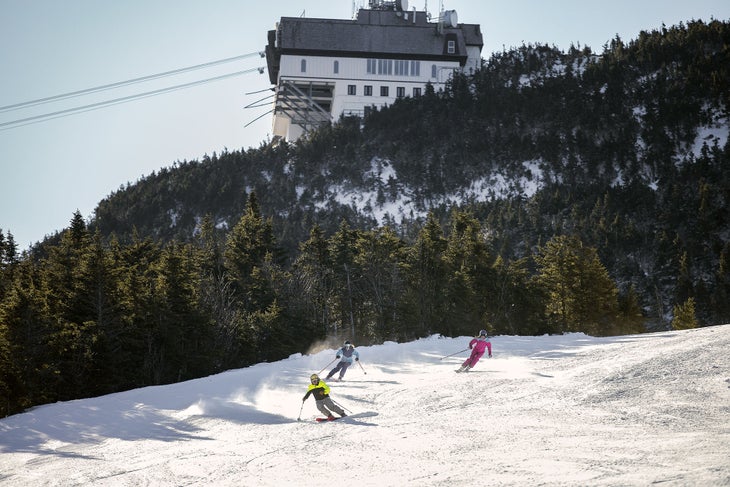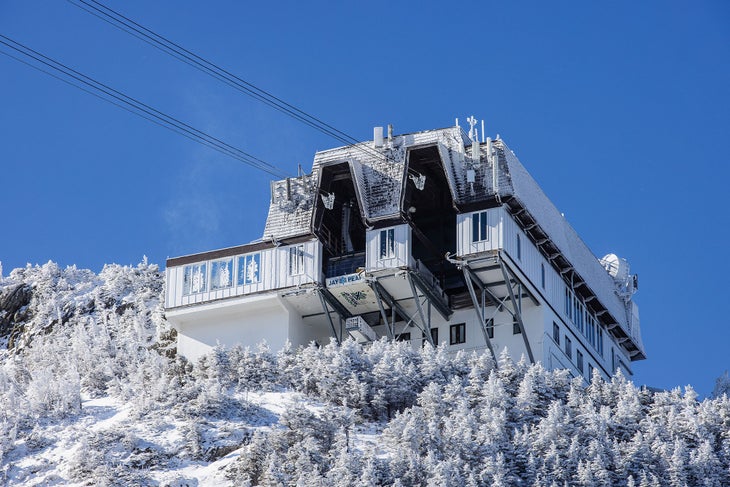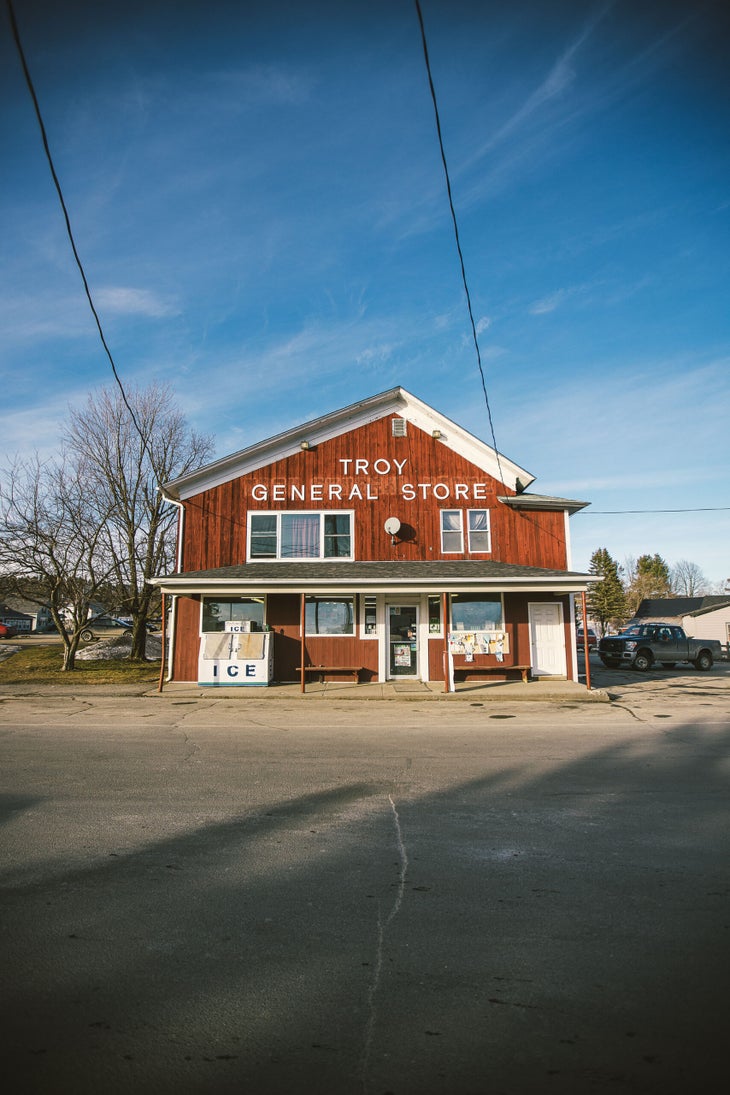Products You May Like
In 2016, it looked like Vermont’s fabled Northeast Kingdom—remote and picturesque, but chronically impoverished—was finally catching the economic break it needed. A remarkable transformation was underway at its two ski areas, Jay Peak and Burke Mountain, where owners were taking unprecedented advantage of the EB-5 Immigrant Investor Program created by Congress to incentivize job growth in high-unemployment zones like the Kingdom.
Through EB-5, foreigners seeking U.S. citizenship could essentially buy their way to the front of the immigration line by investing $500,000 in projects that created jobs. At Jay Peak in particular, the sudden burst of development was astonishing—two new hotels, with a third underway, a giant water park, a hockey rink, and more. Hundreds of Kingdom residents were employed in the construction, and by 2016, Jay Peak had quadrupled its workforce. While the mountain itself remained unchanged—same lifts, trails, and beloved tree lines—the base area had morphed into something like a small city, with every imaginable resort amenity available. This at a place that 10 years earlier had greeted its visitors with a dark, dated base lodge, a dirt parking lot, and little else. Longtime Jay skiers, an exceptionally hardy band of storm-chasing, shut-up-and-ski types, barely recognized their beloved ski area.
The white-haired, bespectacled CEO of Jay Peak, Bill Stenger, who once studied to be a priest, was still the hero of the Kingdom however. While the icon of Jay is its dramatic aerial tram with its massive lattice towers, the face of the place has always been Stenger. Like a lot of hard-nosed Vermont businessmen, Stenger was a guy who, in 2016, opposed overregulation and had had his scrapes with environmental cops, but no one ever doubted that he had the best interests of the Kingdom at heart.
2022 Reader Resort Survey: No. 6 in the East, Jay Peak, Vt.
So it came as a shock when he was suddenly embroiled in the largest financial fraud in Vermont history. In April of 2016, federal agents swarmed the offices of Jay Peak, alleging that Stenger and his boss, Jay Peak owner Ariel Quiros, were involved in what the Securities and Exchange Commission called a “Ponzi-like” scheme to defraud their EB-5 investors.
The SEC identified Quiros as the mastermind. Quiros was little known when he bought Jay in 2008—illegally, as it turned out. As Vermonters would learn, he summered in the Kingdom, had purchased a home at Jay, and had struck up a friendship with Stenger. Quiros would remain behind the scenes right up until 2016, when his fraud was exposed. The SEC accused him of buying Jay using Jay’s own money—a scheme that Quiros, who now faces possible jail time, described as “genius”—and of subsequently running a classic shell game, raising millions from would-be Americans (Stenger did all the work), diverting it for his own use, and covering his tracks with money raised from subsequent investors, illegally mingling funds designated for specific projects.
The SEC seized $81 million worth of assets from Quiros, including Jay and nearby Burke Mountain (the latter acquired in 2014 without Stenger’s involvement). In 2020, Quiros pleaded guilty to federal criminal charges—including wire fraud, money laundering, and obstructing investigators—and is expected to be sentenced to as many as eight years in prison.
Stenger settled with the SEC five months after the seizure. He agreed to cooperate in ongoing investigations and to help see EB-5 projects at Jay to completion, and he was banned for life from the EB-5 program. In August of 2021, he pleaded guilty to a single count of supplying false statements to federal investigators, a conviction that could land him in jail for up to five years. At this writing, both men awaited sentencing.
In the end, a pillar of the community was toppled, and the EB-5 program—once roundly praised by Vermont politicians—was stained by scandal.

First, a Little Background
Owing to its lonely setting on the border, only about half of Jay’s skiers are American. Those tend to be pretty hardcore, willing to drive a little farther for Jay’s two signature traits: deep snow (from the famous Jay Cloud) and tree skiing (long abided, even promoted, by management).
The other half are Canadians. Jay is an easy drive from Montreal, whose nearly 2 million inhabitants love skiing almost as much as hockey, making it a more lucrative market for Jay than most U.S. skiers understand (though Stenger did). Montrealers looking for 2,000 feet of vert have a choice between Tremblant, a giant of the Canadian resort industry, and Jay—each about 85 miles from the city.
The old Jay was a spartan place, with no frills and no quaint village near the base—the antithesis of fully developed Tremblant. The tram, built in 1966 as the only practical way to reach Jay’s cliffy summit, gave it an exotic air. The few skiable lines off the front of the summit were certifiably extreme—the pride of Jay’s hardcore scene. Lots of Jay old-timers preferred the original Stateside terrain, where trails like Can-Am and 601 provided plenty of challenge.
The EB-5-funded transformation was stunning, starting with the Tram Haus Lodge, which, with its boutique feel and sense-of-place decor, took a place among the most appealing slopeside hotels in the Northeast when it opened in 2009. Even as Stenger, with his inexhaustible work ethic, traveled the globe constantly in search of new investors, he oversaw construction of a giant waterpark, two more hotels, countless condos, a parking garage, and yes, Montreal, a hockey rink.
Some of Jay’s most devout old-schoolers grumbled as skier visits soared. But the terrain remained the same, the snow kept falling, and the Tram Haus came with a killer new slopeside bar. Plus all those jobs to keep things humming as smoothly as Stenger envisioned it.

The First Shoe Drops
The peace exploded on April 13, 2016, a Wednesday afternoon at the end of a bad snow year.
“I was heading out to catch my daughter’s track meet,” remembers Steve Wright, Jay Peak’s marketing director, soon to become its president and general manager. The feds showed up in actual black suburbans, but Wright, walking toward his car, had seen guys in suits before.
“We had investors kicking tires, so I was used to suits. The lead guy asked me if I was Bill Stenger, and I said ‘No, I think he’s inside.’ But when I went to move by him he put his hand on my chest and said, ‘Why don’t you come back in.’ I’m thinking, well, that doesn’t sound like a normal investor.”
The suit was an attorney with the SEC, and he had a team of forensic accountants with him there to seize assets.
Trip Planning: Where to Eat, Sleep, Drink, and Play at Jay Peak, Vt.
“They went into every office, asked people to keep their hands on their desks, and the lead attorney came into my office, closed the door, and asked, what’s your name, what do you do here, and did I have an org chart. So I showed him the org chart; he saw where I was on it, and it looked like I was the next closest thing to the boss, and he said, ‘OK, you’re going to be running point here for the foreseeable future.’”
Wright, after 12 years working for Stenger, had a new boss, a lawyer in Miami, appointed by a federal judge in Quiros’s hometown.
That lawyer, the federal receiver, Michael Goldberg, had skied as a kid—“I grew up in New York, so we’d go up to Vermont”—but admits he’s “more of a warm-weather, watersports guy.” Running a ski area, a particularly snowy one in farthest northern Vermont, was now his responsibility. “I had never heard of Jay,” says Goldberg. “I knew nothing of the ski industry, though I’ve learned a lot since then.”
Jay was lucky, because as receivers go, Goldberg is among the most experienced, having done a couple dozen of them. His job would be to keep Jay and Burke running with clean books, preserving jobs, doing everything he could for the investors—in terms of both immigration status and getting their money back—and preparing the resort for sale to new owners. He brought in a resort-management company to help with accounting and running the hotels, and while he was busy chasing assets, paying off creditors, and battling immigration officials, he trusted Wright to run Jay as profitably as possible.
 Both the Ice Haus Arena—an NHL-sized skating rink— and the Pump Haus waterpark were constructed during the Quiros heyday, and have proved to be massive boons for the resort. Photo: Justin Cash
Both the Ice Haus Arena—an NHL-sized skating rink— and the Pump Haus waterpark were constructed during the Quiros heyday, and have proved to be massive boons for the resort. Photo: Justin CashInside the Stenger/Quiros Partnership
It’s easy to imagine Stenger’s anxiety when Jay’s former owners, Quebec’s Sauveur International, put the resort up for sale in 2007. Jay was his baby, and he was just realizing the potential of the EB-5 program and the jobs it could create. He already had $18 million in the bank for construction of the Tram Haus. He needed an owner who would keep him around to see it through; even better, someone who would share his vision for a vastly expanded resort. He would have wanted to believe that in Quiros, the apparently wealthy and successful Miami businessman, he’d found the perfect new owner.
While everyone in the Kingdom knew Bill Stenger, Quiros was a mystery. Years later, as the Burlington Free Press dug into his past, it painted a portrait of a quiet ex-military man with ramrod bearings and a strange, “almost foreign” affect and manner of speech. He wrote his emails in all-caps. He worked from a huge Miami office that projected great success. But he had a track record of somewhat unsuccessful businesses. At press conferences announcing successive EB-5 funded developments, he let Stenger do the talking. And though he was a longtime Kingdom visitor, no one describes him as an avid skier. “I never saw him ski; never heard about him skiing,” says Wright. “He wasn’t here very often. Even when he was, he just didn’t really have much to share.”
Still, Stenger and Quiros struck up a friendship over the years. There would be a falling out between them well before the SEC announced its charges, but before that, Stenger praised Quiros as a guy he could do business with, telling the Free Press of a deal they struck to reserve the best new slopeside lot for Quiros—a deal sealed with a handshake between trusting, likeminded businessmen.
As it turned out, Quiros wasn’t as wealthy as Stenger believed. His financial worth at the time amounted to less than $5 million, much of that in his Florida home. To buy Jay, he needed $26 million.
The key was the $18 million Stenger had raised. Quiros, claiming he needed to verify its existence, convinced the sellers to put it in an account at Raymond James financial services, where his son-in-law worked. In the hours before the closing of the sale, he was able, with the son-in-law’s help, to retitle the accounts in his name and transfer the money through a series of accounts. When he used $13.5 million of it to make the initial payment, it looked like his own money.
Raymond James would pay a $150 million settlement to Goldberg for its involvement in the fraud. The eager-to-please son-in-law would eventually be barred from the financial services industry. But for almost seven years, their crimes went undetected.
Quiros relied on Stenger to continue raising EB-5 funds, which Stenger did with spectacular success, enabling Quiros to pay the balance of the sale price, illegally mingling and misusing investor funds earmarked for specific EB-5 projects. “It was a fraud from the start,” says Michael Pieciak, commissioner of Vermont’s Department of Financial Regulation (DFR). Pieciak led the state’s investigation into Quiros, which started with investor complaints in 2014.
“They had dug themselves into a hole and they needed more and more money to cover their tracks. But they were also building all those projects. And that’s what made this different from a Bernie Madoff or a traditional Ponzi scheme. You could drive up there and see the Tram Haus and Hotel Jay and this and that, so that gave them cover. And they were so public about it. Stenger was telling anyone who would listen about what they were doing. Why would anyone doing something wrong be so public about it?”
Which is exactly how the fraud went on so long.

Finally, the Past Catches Up
In 2014, Pieciak had recently resettled in his home state, fresh from the pressure-cooker world of mergers and acquisitions at a blue-chip Manhattan law firm. He grew up in Brattleboro, Vermont, skiing at the now-defunct but fondly remembered Maple Valley Ski Area, and had just taken a job as deputy commissioner at DFR. Maybe he had worried his new government job would be boring, but within months he found himself
leading a blockbuster investigation.
The seeds of Quiros’s undoing were complaints made by Phase 1 (Tram Haus) investors when Quiros—abruptly and without warning—reclassified their investment. The complaints prompted Gov. Peter Shumlin to ask DFR to look into them, Pieciak says. “At the time, we viewed it as just a contractual dispute between investors and owners.”
He got caught up on the matter, compiled a list of questions, and scheduled a meeting with Quiros’s lawyers, at Jay, in January of 2015—a meeting he recalls vividly. Things started out cordially enough. “I remember them saying ‘we’re glad you’re getting involved, because you (DFR) will get all this financial stuff,’” says Pieciak. “Maybe they’re still glad we got involved,” he wryly adds.
By now, Quiros had been misusing investor money for years, skimming much of it for his own use: tax bills, a Trump Tower condo, another on Fifth Avenue. When Pieciak drilled down for answers on where the investor money was, he got evasive answers. Painting Quiros as a “brilliant businessman,” they described complex transactions that immediately sounded suspicious to Pieciak.
Go Deeper: The 20 Best Ski Resorts in the East
“It was all really complicated, and not something you see well-run corporations do. They were moving money around in ways that didn’t make sense,” says Pieciak.
Another red flag, “more of a gut thing,” came when Pieciak asked if they had sufficient funds to pay investors who might want to pull out, as would be their right given changing assumptions. “They said Mr. Quiros was a man of untold wealth—I believe those were the exact words—that basically Quiros had so much money he could take care of it no problem. And that’s right out of the Bernie Madoff playbook, where you create a sense of extravagance and success and great wealth, and it’s all hiding something mischievous going on beneath the surface. Definitely another red flag for me.”
Finally, state officials had recently learned that the SEC’s Miami office was looking into Quiros’s dealings, based on tips from investors. When Pieciak asked, the lawyers said that was true, but that they hadn’t heard anything from the SEC in months. Pieciak got in touch with Miami SEC the next day to see if that checked out. “It didn’t check out.” The SEC said it had been “talking to them constantly over the past six months.”
Together, the SEC and DFP built their case against Quiros. It took time to build trust between the two agencies. The Miami investigators, Pieciak says, were reluctant to trust anyone from Vermont. “Stenger was well connected. Anyone from Vermont might paint things in a light favorable to Jay Peak, or relay information.”
But the collaboration bore results. Quiros’s fraud, more brazen than brilliant, did not withstand scrutiny.

The Golden Boy Gets Tarnished
Through it all, many Vermonters, especially in the Kingdom, especially at Jay, held out hope that Stenger wasn’t the bad guy.
“There’s a big contingency of people up here who are still huge Bill Stenger fans,” says Michael Minkoff, who has owned a slopeside condo at Jay for about six years and just bought another one. “All he did was get in bed with the wrong person. But that guy Quiros, they should put him in jail and throw away the key. He was clearly the bad guy. I never met him, but now I’ll be sleeping under his roof.”
“Sleeping under his roof,” because the condo Minkoff bought was Quiros’s—the one on the nicest lot with the best views, reserved on a handshake. It was seized by the receiver in 2016, then listed for sale in late 2020 at $550,000. Minkoff, a high-end developer with celebrity clients in the Hamptons, thinks the state could have gotten $600,000. He plans a “total gut renovation” of the five-bedroom unit. “The first thing we did was get some of those smudge sticks. I don’t really believe in this stuff, but we had to smudge the unit to, you know, get all the bad spirits out.”
In fact, while Stenger may have had the best interests of the Kingdom at heart—and may not have known the extent of Quiros’s financial misdeeds—he is apparently not without sin. Pieciak remembers making a surreptitious trip to Jay during the investigation to check on the progress of a particular project.
“The SEC had asked about some townhouses, and Stenger had filed a response saying they’d all been built and were doing well, and Miami asked if we could go up there and take a look. So we drove up, found the address, and we had the sketches of what it should look like, and it basically was three piles of dirt and, like, a cement cauldron. And that was it.”
There were other examples of the “construction not living up to what was sold to investors,” says Pieciak, including a bowling alley, a spa, and dozens of hotel rooms that were never built. “As far as the financial piece, it’s clear that Stenger wasn’t getting all the information, and that after the falling out he knew even less. But he was overseeing construction, so there’s a harder story to explain there.”
Meanwhile, Goldberg says he found no evidence that Stenger ever diverted funds for personal use, as Quiros did. He even employed Stenger as a consultant for a time and says he was a great help. “In a lot of cases where someone gets indicted, they hide or they obstruct things. Bill Stenger did none of that. He cooperated. He assisted. He was always willing to help, which was like night and day from the others involved. I personally have not seen any evidence of Bill acting wrong, and had I seen it, I would not have employed him. I like Bill.”

Looking Forward
In nearby Newport, where Wright and many other Jay employees live, there’s an ugly hole in the ground at the center of downtown. After raising EB-5 money to build a hotel and marina there, Quiros and Stenger got only as far as demolishing the existing structures. At a nearby site where a biomedical research facility was planned, even less was accomplished, though $80 million was raised from investors dreaming of U.S. citizenship.
At Jay, it’s a different story. “When this all started we had a couple hundred people on the payroll, fewer than 150 full-time,” says Wright. “Now we’re up to 12- or 13-hundred in the winter, and half of those are full-time, year-round.”
Under Goldberg’s receivership, annual profits increased from a little over $2 million a year to more than $10 million in the year before Covid (which, for a resort that relies so heavily on Canadian visitors, has been especially troublesome).
And while Quiros may have stolen millions and lived a lavish lifestyle for a time, he didn’t get away with it. “Hats off to the SEC and to Vermont’s Department of Financial Regulation,” Goldberg says, “because in the end those two agencies discovered the fraud and brought an end to it.” Contractors and vendors who were owed money have been paid, he notes, and he’s confident that the downtown Newport project will be completed by another developer.
“I don’t think there are any victims left other than the investors,” Goldberg says. “I don’t know if they’ll ever get their money back, because it’s quite possible it was not a good investment. And while everyone views them as wealthy, many struggled to come up with the $500,000, and this will be a significant hit for them. I will do my utmost to get their immigration status approved, but they are victims of a fraud.”
Meanwhile, Stenger’s vision for Jay has been largely realized, and the EB-5 program, despite the fraud, did what it was supposed to do. “At the end of the day, the system worked,” says Goldberg. “There’s a resort employing hundreds of people. It accomplished what it was intended to accomplish, and the government caught the bad guy. The system worked.”
As of November 2021, the Northeast Kingdom had already been blanketed by the season’s first snowfalls. Goldberg had yet to find a buyer for the resort but claimed to have several interested parties looking over the financials. And while it’s hard to imagine a Jay Peak without Bill Stenger, whoever buys the place acquires a resort that fully realizes his vision, plus two intangible assets: The Jay Faithful, as devoted a following as there is in skiing, will return, knowing that as the cloud of controversy lifts, another cloud, the Jay Cloud, will deliver the goods in the form of the fluffy white stuff we all crave.
